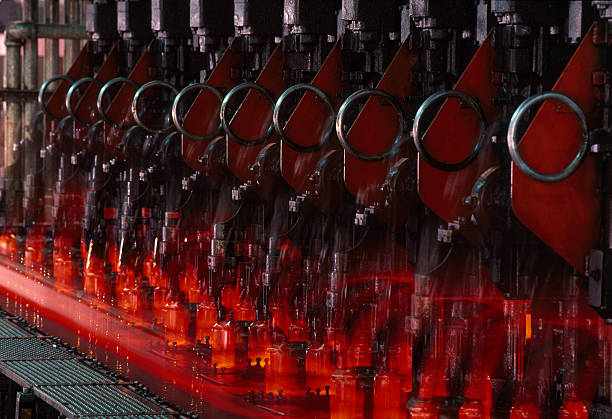
Glass Manufacturing
Three machines that cannot be stopped, why do glass factory machines lose millions of dollars if they stop for a day?
Glass is an indispensable material in our daily lives, from windows to tableware, from phone screens to car windshields, the application of glass is everywhere.
But did you know that the production process of glass is very complex and precise, and any mistakes can cause huge losses. Today, let’s take a look at why glass factories cannot stop production and the three machines they rely on that cannot be stopped.
1、 Why can’t the glass factory stop production?
The production line of a glass factory is a continuous assembly line, from the mixing, crushing, and melting of raw materials to the forming, annealing, cutting, and inspection of glass, each step requires precise control and coordination. If the operation is stopped during the production process, it will lead to serious consequences in the following three aspects:
Firstly, the production line of the glass factory operates at a certain speed and pace. If stopped midway, it will affect the progress of subsequent processes, resulting in a decrease in production efficiency and delays in orders.
According to statistics, a regular glass production line can produce about 200 square meters of glass per minute. If stopped for a day, it will lose about 288000 square meters of glass. If calculated at a price of ¥ 10 per square meter, the daily loss would be as high as 2.88 million RMB.
Secondly, the production line of the glass factory is in a high-temperature and high-pressure environment. If stopped midway, it will cause changes in temperature and pressure, affecting the fluidity and stability of the glass liquid. This will cause the glass liquid to solidify or crystallize inside the equipment, causing blockage or damage to the equipment.
At the same time, during the solidification process of glass liquid, shrinkage and stress changes occur, leading to defects such as cracks, bubbles, and deformation in glass products. This will reduce the quality and safety of glass products.
Finally, the production line of a glass factory is a high energy consuming industry, and if stopped midway, it will lead to energy waste and increased costs. Firstly, after stopping operation, the equipment still needs to maintain a certain temperature and pressure to prevent damage to the equipment and raw materials.
This will consume a large amount of resources such as electricity, fuel, and water. Secondly, after restarting the operation, the equipment needs to be reheated and debugged to achieve normal working conditions. This will increase investment in energy and manpower.
It is estimated that a regular glass production line requires approximately 2000 kilowatt hours (kWh) of electricity per hour, and if stopped for a day, it would waste approximately 48000 kWh. If calculated at a electricity price of 0.6 yuan per kilowatt hour, the daily energy loss would be as high as 28800 RMB.
In summary, once the production line of a glass factory stops operating, it will cause huge losses in terms of output, quality, and energy consumption, and may even lead to equipment scrapping and factory bankruptcy. Therefore, glass factories must maintain continuous operation of production lines to ensure production efficiency and quality.
2、 The three non-stop machines that the glass factory relies on
The production line of a glass factory is composed of various machinery and equipment, among which three machines are the most relied upon by the glass factory.
1. Melting cellar
A melting cellar is the core equipment of a glass production line. It is a large container made of refractory materials, used to heat raw materials to high temperatures and melt them into a uniform, bubble free glass liquid. The temperature of the melting pit is generally above 1500 ℃, and it is necessary to continuously supplement raw materials and adjust the flame.
The melting pot cannot stop running because once it stops, the glass liquid will solidify inside, making the melting pot unusable. Moreover, the lifespan of the melt cellar is generally only a few years, and replacing the melt cellar requires a lot of time and money.
2. Forming machine
The molding machine is an important equipment in the glass production line, which is used to shape and size the glass liquid according to the predetermined shape and size. There are various types of molding machines, which vary depending on the type of glass product.
For example, the molding machine used to manufacture flat glass is a float production line, which uses glass liquid to float on the surface of the tin liquid and cool it into shape. The molding machine cannot stop running because once stopped, the glass liquid will block or cool and deform at the outlet, causing the molding machine to malfunction.
3. Annealing furnace
Annealing furnace is a necessary equipment for glass production line, which is used to slowly cool the formed glass within a certain temperature range. Annealing furnaces can eliminate stress and cracks inside glass, improving the strength and stability of glass products. The annealing furnace cannot be stopped because once stopped, the glass products will rapidly cool inside, causing cracking or bursting of the glass products.
epilogue
Through the above introduction, we can understand why glass factories cannot stop production and the three machines they rely on that cannot be stopped. These machines are designed and operated to ensure key factors such as temperature, pressure, fluidity, and stability during the glass production process.
If any link encounters a problem, it will affect the normal operation of the entire production line. Therefore, when it comes to processing an order, it is common to encounter scheduling or early delivery. However, relying on our BOLITE professional and strong team, we will try our best to control this risk within the smallest possible range. Therefore, it is not difficult to see the importance of choosing a strong supplier.
Contact Us





